

Untitled. Africa has plenty of land. Why is it so hard to make a living from it? - Farming in Africa. The innovation turning desert sand into farmland. Faisal Mohammed Al Shimmari farms in some of the most extreme conditions in the world, at Al Ain, an oasis in the United Arab Emirates desert, where temperatures can reach 50C.

"It's expensive as we have to buy water regularly to irrigate these plants," he says. Making the desert sand bloom. Vox - The effects of deforestation, water use, urban... Countrywisejo. Green Matters - Scientists found an inexpensive way to... Why is Africa building a Great Green Wall? As a river dies: India could be facing its ‘greatest human catastrophe’ ever. INDIA: Much of the once bountiful and lush-green rice fields was reduced to a dry, yellow-brown landscape, after successive years of scanty rainfall and severe drought.
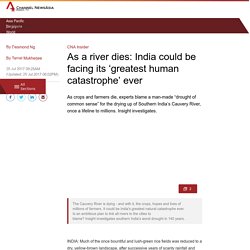
For farmer Mr Vijayakumar, 52, the rice crop was his family’s sole source of income. Hit by the double whammy of crop failure and mounting debts, he took a lonely walk to the edge of his two-acre rice field in Tamil Nadu in January this year. There the tough, rugged man, used to the hard toil of a farmer for decades, hanged himself from a nearby tree. “He was constantly worrying about the debts,” said his wife Vijayakumari, who is now struggling to cope with the loss of her husband and their escalating debts. “His mind was never at peace. Mr Vijayakumar had borrowed from moneylenders to pay for his daughter’s wedding and for fertilisers for his crops which didn’t grow, she told the Channel NewsAsia programme Insight. Facebook. Turning goats into water: A solution for the desert.
How southern Africa is coping with worst global food crisis for 25 years. Angola Drought is affecting 1.4 million people across seven of Angola’s 18 provinces.
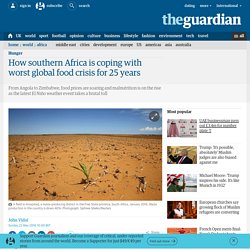
Google. The Earth's Driest Desert Just Exploded In A Sea Of Pink Flowers. Ethiopian farmers made a desert bloom again. Ethiopia is in the middle of the worst drought in 50 years.
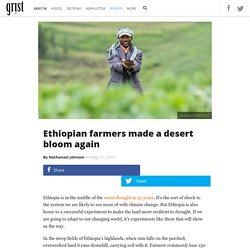
It’s the sort of shock to the system we are likely to see more of with climate change. But Ethiopia is also home to a successful experiment to make the land more resilient to drought. If we are going to adapt to our changing world, it’s experiments like these that will show us the way. In the steep fields of Ethiopia’s highlands, when rain falls on the parched, overworked land it runs downhill, carrying soil with it. Farmers commonly lose 130 tons of soil per hectare a year, comparable to the worst erosion documented on U.S. farms in recent history.
This cycle turned a watershed in Adisghe County, Ethiopia, into a near desert, prompting the government to consider moving the farmers. Scientific Facts on Desertification. Home » Desertification » Level 1.
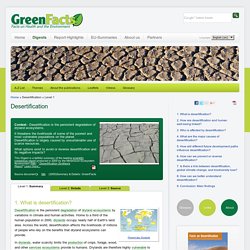
China is building another great wall — of trees. To hold back the desert. As of this writing, the Gobi Desert in northern China/southern Mongolia is about half a million square miles (1.3 million km2) in area.

Yes, that's “as of this writing" — because the Gobi Desert is growing. Due to something called “desertification," about 1,400 square miles (3,600 km2) of China's otherwise arable land is turned into desert each year, as the Gobi creeps further and further south. To make matters worse, winds often pick up the sand, blowing it toward the densely populated areas in China, resulting in immense dust storms. India: 200,000 refugees in Assam's devastating floods.
More than 40% of the region is at risk and severe floods occur every few years, eroding riverbanks and dumping large amounts of sand on farmland, often rendering lands infertile.

Heavy flooding has affected more than a million people in the north-eastern Indian state of Assam, with 45 dead and more than 200,000 in relief camps. And yet there is still very little coverage of the disaster in the international media - perhaps not surprising when you consider even most Indians aren't paying attention. Nestle Continues Stealing World's Water During Drought. Nestlé is draining California aquifers, from Sacramento alone taking 80 million gallons annually.

Nestlé then sells the people's water back to them at great profit under many dozen brand names. Climate renews famine risk to Africa's Sahel. In 2000, 19% of the Sahel's total primary production was consumed.

Ten years later, consumption had increased to 41%. Interactive Dust Bowl. Conserving soil: precious, finite and under threat. Our very survival depends on this very thin layer of soil that is found in only a small fraction of the earth's surface.
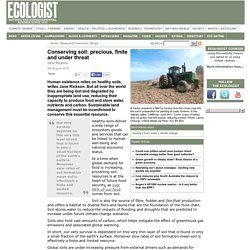
Moreover slow rates of soil formation mean soil is effectively a finite and limited resource. Healthy soils deliver a wide range of ecosystem goods and services that can be linked to human well-being and national economic status. At a time when global demand for food is increasing, protecting soil resources is at the heart of future food security, as over 94% of our food comes from soil. Soil is also the source of fibre, fodder and (bio)fuel production and offers a habitat to diverse flora and fauna that are the foundation of the food chain. Soil stores water to reduce the impacts of flooding and droughts that are predicted to increase under future climate change scenarios. Soils also hold vast amounts of carbon, which helps mitigate the effect of greenhouse gas emissions and associated global warming.
The impact of 'land mining' on future food production. Over-grazing and desertification in the Syrian steppe are the root causes of war. A major role in this unfolding disaster was played by affluent urban investors who threw thousands of livestock into the steppe turning the grazing into a large-scale, totally unsustainable, industrial practice. Back in 2009, I dared to forecast that if the rampant desertification process gripping the Syrian steppe was not halted soon, it could eventually become a trigger for social turmoil and even for a civil war.